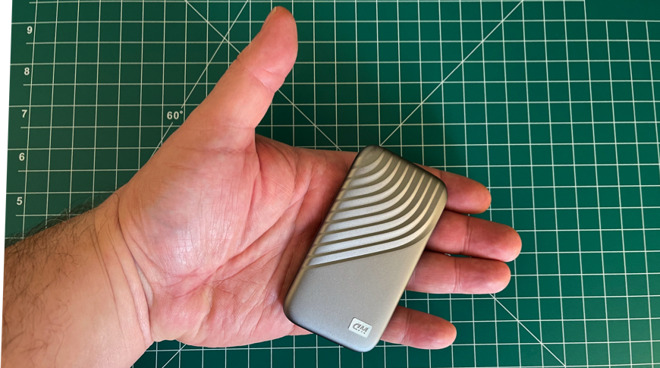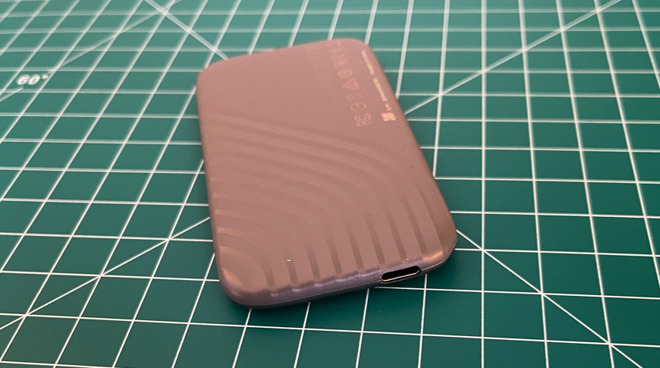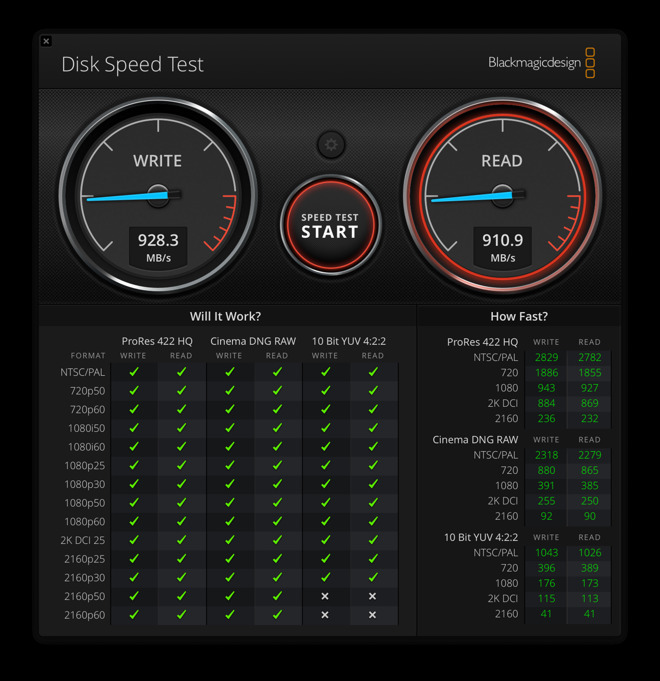WD My Passport SSD review: brings zippy NVMe to the table
The WD My Passport SSD is an inexpensive and reasonable way to upgrade storage on your MacBook Pro, packed into a stylish and compact casing you can carry around anywhere.

If you have picked up an M1-equipped Mac mini or MacBook Air, one of the things that will be an issue is expanding its storage capacity. Since there are no upgrade options available, consumers will have to instead look to external storage options, and that typically means a portable hard drive of some description.
Western Digital's My Passport line is long-running, and one that aims to provide storage that can move with the user wherever they go. The My Passport SSD has been updated for 2020, improving its speed and refreshing the appearance of the portable drive.
While a little larger than the previous generation and slightly thinner, the drive is still extremely pocketable and can easily be carried around in a bag.
The two-tone casing of the previous version has been switched for a metal enclosure with a sweeping motif and is available in a variety of five colors. While the last version was a little garish, the new version is understated but is still stylish in its own right.
The metal casing also helps keep it protected, with its shock and vibration resistance accompanied by drop resistance to a height of up to 6.5 feet. This means the drive will easily take the rigors of daily use without too much trouble.
One good design choice is the use of a separate USB-C cable, which is easily user-replaceable. This does open up the possibility of losing the cable itself, but it will still work with any USB Type-C cable.

What's included with the WD My Passport SSD
As well as being supplied with a (too short) USB Type-C to Type-C cable, WD includes a USB Type-C to Type-A adapter in the box. This gives the ability out-of-the-box for the drive to work with USB-A 3.0 and USB 2.0 ports at slower speeds.
We're not fond of this cable, and the rigidity of the cable isn't great. Fortunately, better replacement cables are cheap and plentiful.
The drive is listed as supporting USB 3.2 Gen 2 at up to 10Gb/s. Given that it is a USB drive, it is backward compatible with the right cabling.

WD offers the drive in three capacities, covering 500GB, 1TB, and 2TB, with the 1TB version used for this review.
We routinely saw speeds of about 930 megabytes per second write and 910 megabytes per second read in the real world. With extended hammering of the drive speed test, thermal throttling drove speeds down to about 720 megabytes per second read and write -- still faster than a single SATA-based SSD can deliver.

WD My Passport SSD 1TB speeds
When connected to a USB 3.0 type A port, speeds were limited to about 410 megabytes per second for reads, and 400 megabytes per second write. These speeds are about what we expected, given the limitations of the port.
The WD Discovery for Mac software is adequate, but we aren't going to delve into it too much here. When encryption is enabled, speeds are limited to about 700 megabytes per second read, and 550 megabytes per second write on a 15-inch i9 2018 MacBook Pro or an M1 Mac mini, and a hair less on a 2016 15-inch MacBook Pro.
While WD has its own backup software, Mac users have better options. For starters, not even including third-party cloning software, the drive also supports macOS's Time Machine. However, it does have to be reformatted beforehand -- which most Mac users generally do anyway, unless they're working cross-platform.
WD states the drive will work right out of the box with exFAT formatting on both PCs and Macs. On the PC side, it supports both Windows 10 and Windows 8.1, and can do so for other operating systems, again with reformatting.
Its small size and high capacity make it a no-brainer for MacBook Air and MacBook Pro users to bring along with them. The drive is also reasonably priced for what it provides and is a good option to expand storage -- albeit externally -- on Macs that can sometimes have very high pricing on additional storage internally.
The WD My Passport SSD is a solid, uninspiring external USB-C drive, a product that is readily available from most electronics manufacturers. Not everything needs to be ground-breaking or have record-breaking speeds. Sometimes you need a $10 hammer to get the job done instead of a $120 ergonomic design, custom-tailored to fit your hand.
The WD My Passport SSD is the epitome of the right tool to get the work done, without breaking the bank.
Pros

If you have picked up an M1-equipped Mac mini or MacBook Air, one of the things that will be an issue is expanding its storage capacity. Since there are no upgrade options available, consumers will have to instead look to external storage options, and that typically means a portable hard drive of some description.
Western Digital's My Passport line is long-running, and one that aims to provide storage that can move with the user wherever they go. The My Passport SSD has been updated for 2020, improving its speed and refreshing the appearance of the portable drive.
Key specs
- Options for up to 2TB in capacity
- 256-bit AES hardware encryption
- USB-C 3.1 Gen 2 ready
- USB Type-C to USB Type-A converter included
- Up to 1,050MB/s read speeds and 1,000MB/s write speeds
- Drop protection to 6.5 feet
- 3.94 inches by 2.17 inches by 0.35 inches
- 5-year warranty
Small stature
The My Passport SSD's casing is small, measuring just 0.35 inches thick, 3.94 inches long, and 2.17 inches wide. It's also fairly light with a weight of 45.7 grams (1.6 ounces).While a little larger than the previous generation and slightly thinner, the drive is still extremely pocketable and can easily be carried around in a bag.
The two-tone casing of the previous version has been switched for a metal enclosure with a sweeping motif and is available in a variety of five colors. While the last version was a little garish, the new version is understated but is still stylish in its own right.
The metal casing also helps keep it protected, with its shock and vibration resistance accompanied by drop resistance to a height of up to 6.5 feet. This means the drive will easily take the rigors of daily use without too much trouble.
One good design choice is the use of a separate USB-C cable, which is easily user-replaceable. This does open up the possibility of losing the cable itself, but it will still work with any USB Type-C cable.

What's included with the WD My Passport SSD
As well as being supplied with a (too short) USB Type-C to Type-C cable, WD includes a USB Type-C to Type-A adapter in the box. This gives the ability out-of-the-box for the drive to work with USB-A 3.0 and USB 2.0 ports at slower speeds.
We're not fond of this cable, and the rigidity of the cable isn't great. Fortunately, better replacement cables are cheap and plentiful.
The drive is listed as supporting USB 3.2 Gen 2 at up to 10Gb/s. Given that it is a USB drive, it is backward compatible with the right cabling.
Capacity and performance
As part of the refresh, WD has updated the type of storage inside the drive itself, moving the line over to higher-speed NVMe. WD claims read speeds of up to 1,050MB/s and write speeds of up to 1,000MB/s on USB-C 3.2 gen 2.
WD offers the drive in three capacities, covering 500GB, 1TB, and 2TB, with the 1TB version used for this review.
We routinely saw speeds of about 930 megabytes per second write and 910 megabytes per second read in the real world. With extended hammering of the drive speed test, thermal throttling drove speeds down to about 720 megabytes per second read and write -- still faster than a single SATA-based SSD can deliver.

WD My Passport SSD 1TB speeds
When connected to a USB 3.0 type A port, speeds were limited to about 410 megabytes per second for reads, and 400 megabytes per second write. These speeds are about what we expected, given the limitations of the port.
Security and compatibility
Like the earlier version, WD includes 256-bit AES hardware encryption in the drive, allowing users to encrypt the data with a minimal hit to performance. The encryption element relies on using the included WD Discovery software, which can also be used to automate backups, but does require Internet activation beforehand.The WD Discovery for Mac software is adequate, but we aren't going to delve into it too much here. When encryption is enabled, speeds are limited to about 700 megabytes per second read, and 550 megabytes per second write on a 15-inch i9 2018 MacBook Pro or an M1 Mac mini, and a hair less on a 2016 15-inch MacBook Pro.
While WD has its own backup software, Mac users have better options. For starters, not even including third-party cloning software, the drive also supports macOS's Time Machine. However, it does have to be reformatted beforehand -- which most Mac users generally do anyway, unless they're working cross-platform.
WD states the drive will work right out of the box with exFAT formatting on both PCs and Macs. On the PC side, it supports both Windows 10 and Windows 8.1, and can do so for other operating systems, again with reformatting.
Small and mighty
For those needing to have external storage, you can't really go wrong with the WD My Passport SSD. Its use of NVMe means it is faster than ever before, coupled with the metal enclosure and built-in hardware encryption can help keep your precious data safe.Its small size and high capacity make it a no-brainer for MacBook Air and MacBook Pro users to bring along with them. The drive is also reasonably priced for what it provides and is a good option to expand storage -- albeit externally -- on Macs that can sometimes have very high pricing on additional storage internally.
The WD My Passport SSD is a solid, uninspiring external USB-C drive, a product that is readily available from most electronics manufacturers. Not everything needs to be ground-breaking or have record-breaking speeds. Sometimes you need a $10 hammer to get the job done instead of a $120 ergonomic design, custom-tailored to fit your hand.
The WD My Passport SSD is the epitome of the right tool to get the work done, without breaking the bank.
Pros
- Compact size and lightweight.
- Separate USB Type-C cable.
- Shock and drop resistant.
- Adequate but not great encryption suite.
- Fast transfer speeds
- Included cable is quite short.
- Reformatting needed for Time Machine.

Comments
BTW, that short cable is exactly what you want. You don't need to ever touch the drive except to plug it in and un plug it. These drives dangle off the USB port with the cable giving enough clearance so you can plug in other things to other ports.
I agree that a short cable is good, but a four-inch one is a hair too short. Six to eight inches of cabling, and you get more flexibility, with none of the disadvantages of a two-foot cable in a small space.
They all seem to perform as advertised, and that disappoints me. None of these drives come anywhere near the theoretical maximum bus protocols, to wit:
USB 2.0, up to 480Mbps
USB 3.0, up to 5Gbps
USB 3.1, up to 10Gbps
USB 3.2, up to 20Gbps (Gen 2)
USB 4.0, up to 40Gbps
There's been some musical chairs with the USB naming convention, and I want to avoid that as I don't think it germane to my question.
The real world speeds seem to be about half the max or less. Even counting for overhead, the throughput never seems to come close to saturating the bus. To get greater throughput the practice seems to be create another protocol, get another type of drive, connector, and external case, and get a fraction of the new theoretical performance limit. Not to mention none of this equals the speed of Apple internal flash memory (no doubt part of that is due to being internal).
The tested WD drive above seems to get <1Gbps, nowhere near the TM, but that's fast? Compared to a spinner, sure that's true. But it seems like getting an external that comes close to TM is like getting 50,000hrs out of an LED or CFL. (Of course, someone here has done that.)
I'm not prone to conspiracy theories, so can someone point out the whys and wherefores of science for my missing the point? Is it a consumer/prosumer vs commercial user thing? Allowing for scary RAID performance? Off for some Tylenol. I don't know if I even got my questions right.
USB 3.2 Gen 2 (which is actually 2x1) is 10 Gbps, just like USB 3.1 Gen 2.
I found the table at https://en.wikipedia.org/wiki/USB_3.0#USB_3.2 very helpful.
What is 20 Gbps is USB 3.2 Gen 2x2. It is worth noting that Apple does not have any device supporting this, so USB 3.1 Gen 2 at 10 Gbps is the fastest USB you'll get with any Mac.
(USB-IF has really messed up the naming! It was simplified to "Superspeed USB 10 Gbps" and "Superspeed USB 20 Gbps" 2019, but hasn't caught on yet.)
At least with USB 3.1 Gen 2 and 3.2 Gen 2 (and 3.2 Gen 2x2, jeez this is a mess) the encoding is more efficient at 128b/132b instead of 8b/10b.
I think you're underestimating the actual overhead involved, not only on the communication side of things, but the system overhead, i.e., everything that needs to happen on the Mac/PC side of things as well, like servicing interrupts, thread scheduling, context switching, handling page faults, etc. It's been a while, but the last time I looked at evaluating (100 Mbps) Ethernet performance for "soft real time" control applications I recall that the network performance was unreliable for soft real time control when the network utilization exceeded around 10% because of the collision detection & fallback built into the wire protocol. Additionally, commercial operating systems like Mac and Windows, place a very high priority on user interface functions and would occasionally interrupt pretty much everything on the box for some OS related overhead. Neither Mac nor Windows (or even most flavors of Linux) are suitable for hard real time control. Even today where Ethernet is used in a number of industrial control applications they all use UDP (or a non standard variation of UDP) rather than TCP because of the excessive overhead built into TCP. USB is no different than any other communication network/bus, it still the OSI 7-layer communication model and even if some of them are combined as with TCP, it still has significant overhead.
As consumers we really only care about our data and information that it is moved from point A to point B. We can determine this by measuring how long it takes to move X number of bytes, our big file, from point A to point B, i.e., the net value. What we don't realize is that our data/information is simply the payload in a communication system that has protocols to ensure that each packet of our data (the payload) is sent and received properly, in the correct order, without errors, and if errors were encountered, retries are performed to recover the missed data. All the while the communication network/bus that is being used is often shared with others, and the computing resource, whether in a dedicated chip or in a core of the main processor, is sharing its available execution cycles with other processes running in parallel at the same time. When you factor all of the connection management, packet management (fragmentation and reassembly), marshaling/unmarshaling, wire format encoding/decoding, flow control, handshaking, error detection, handshaking, and reading and writing from the media on both ends - all this necessary overhead takes away from the net performance that we actually care about, which is how long does it take to move my file from point A to point B.
Here's an example for "USB 3.0, up to 5Gbps"
1) Divide bits by 8 to get bytes => 625 megabytes per second (raw)
2) Account for byte encoding to USB 3 wire protocol format (adds 2 bits to every byte) => 500 megabytes per second (raw)
3) Packet framing, flow control, protocol overhead (~20% hit based on industry data) => 400 megabytes per second (net)
What AppleInsider measured (410 megabytes per second) is very much in-line with industry expectations.